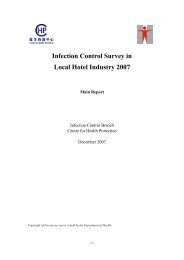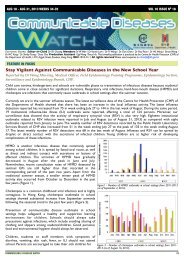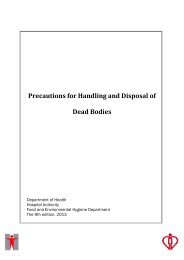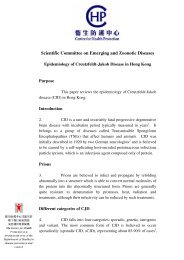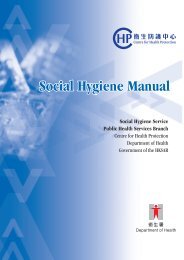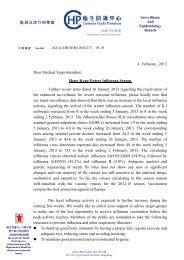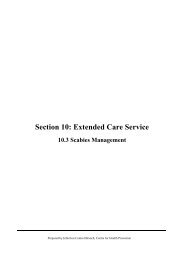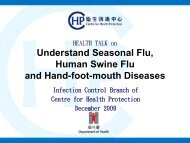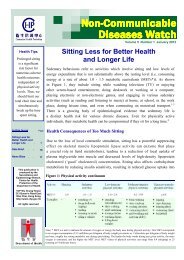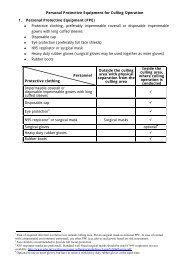Integrating Gloves and Hand Washing Practices
Integrating Gloves and Hand Washing Practices
Integrating Gloves and Hand Washing Practices
You also want an ePaper? Increase the reach of your titles
YUMPU automatically turns print PDFs into web optimized ePapers that Google loves.
(d) Regular use of glove contributes to skin problems <strong>and</strong> latex allergies<br />
[11]. In highly exposed groups, it may even increase the occurrence of<br />
certain serious IgE-mediated reactions. This subject was recently<br />
reviewed [12].<br />
(e) Alcohol-based h<strong>and</strong> rub solutions are designed <strong>and</strong> evaluated for<br />
application on the h<strong>and</strong>s <strong>and</strong> not on gloves [3, 22-23]. There is no need<br />
to apply alcohol-based solution to “disinfect” unused gloves, which are<br />
sufficiently “clean” for infection control purposes. Actually, alcohol rub<br />
solutions will harden the latex <strong>and</strong> thus loosening out the integrity <strong>and</strong><br />
the gloves may become not protective from glove micro-leaks [27]. The<br />
same pair of used gloves should not be used between patients or move<br />
from “dirty” to “clean” body sites in the same patient. Used <strong>and</strong> dirty<br />
gloves should be removed. Worn gloves should not be washed or<br />
disinfect with alcohol-based solutions <strong>and</strong> reuse [14]. Failure to remove<br />
gloves after “patient contact” or between “dirty” <strong>and</strong> “clean” body-site<br />
care on the same patient is an instance of nonadherence to st<strong>and</strong>ard<br />
h<strong>and</strong>-hygiene recommendations [3, 26].<br />
4. For the above reasons, the SCIC has the following<br />
recommendation:<br />
There is evidence that the improper use of gloves is a hazard to patients.<br />
Institutions <strong>and</strong> infection control practitioners are suggested to take measure<br />
to monitor <strong>and</strong> to promote the proper <strong>and</strong> judicious use of gloves for isolation<br />
precautions.<br />
Gloving <strong>and</strong> H<strong>and</strong> <strong>Washing</strong><br />
5. Gloving doesn’t remove the need for h<strong>and</strong> washing. Following<br />
removal of gloves, alcohol-based h<strong>and</strong> rub is normally NOT a substitute for<br />
h<strong>and</strong> washing. The rationale is as follows:<br />
(a) H<strong>and</strong>s can be contaminated even when gloves are used, <strong>and</strong> are easily<br />
contaminated in the process of removing gloves [13]. Following<br />
removal of gloves, studies have shown that h<strong>and</strong>s are commonly<br />
contaminated by nosocomial pathogens such as methicillin-resistant<br />
Staphylococcus aureus (MRSA) with rates of up to 50% [14]. Despite<br />
attention to how gloves were removed, occult breaks in unused latex<br />
gloves can cause substantial contamination of the h<strong>and</strong>s [15]. It should<br />
be pointed out that the tests approved by the U.S. Food <strong>and</strong> Drug<br />
Administration for assessment of the barrier quality of gloves includes<br />
visual inspection <strong>and</strong> a water leak test; neither methods directly evaluate<br />
ability of gloves to prevent penetration by bacteria <strong>and</strong> virus. According<br />
to Korniewicz et al, 20% of latex gloves which had passed the<br />
watertight test allowed penetration of bacteria to the h<strong>and</strong>s [16]. After<br />
use in clinical settings, studies found that glove leaks were frequent<br />
3



